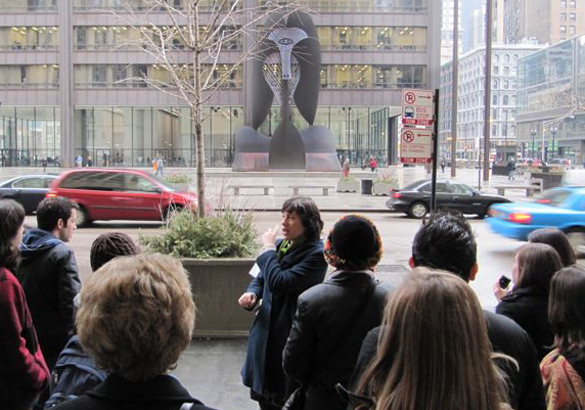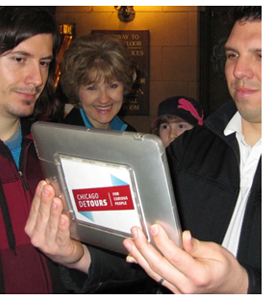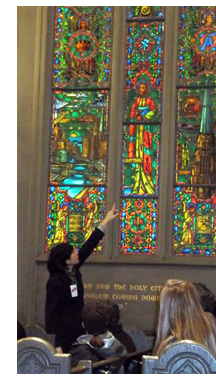| Sun | Mon | Tue | Wed | Thu | Fri | Sat |
|---|---|---|---|---|---|---|
| 1 | 2 | 3 | 4 | 5 | ||
| 6 | 7 | 8 | 9 | 10 | 11 | 12 |
| 13 | 14 | 15 | 16 | 17 | 18 | 19 |
| 20 | 21 | 22 | 23 | 24 | 25 | 26 |
| 27 | 28 | 29 | 30 | 31 |
CATEGORIES
RECENT ENTRIES
BLOG ROLL
A detour worth taking
With a UChicago-style guide, two hours in the Loop cover surprising ground.
By Elizabeth Station

Leading a walking tour of the city for Chicago Detours, Amanda Scotese radiates the brisk confidence of a veteran guide and the friendliness of your favorite TA. That’s no accident. Before founding the company in 2010, she did research and tours for Rick Steves in Italy and studied architecture, urbanism, and history in UChicago’s Master of Arts Program in the Humanities.
Early in March I joined Scotese for a two-hour tour of downtown Chicago that promised to “explore the Loop without freezing.” About 20 participants—from the city, suburbs, and Oklahoma—gathered in the Chase Tower’s bright lobby on a drizzly morning. “We’re only going to walk half a mile, but there’s a lot to cover,” warned Scotese as she handed out three iPads to designated helpers.

Gathering around the iPads, we watched a short video about the Loop. Then Scotese laid out a two-minute history of Chicago architecture, encouraging us to “decode the cityscape” and “read the visual features” of the buildings around the plaza. We learned, for example, why the Italian Village restaurant stands stubbornly among modernist skyscrapers (the owners refused to sell), and the ornamentation got lopped off the top of the Walgreen’s at Clark and Monroe (lousy mid-20th-century taste).
Walking north on Clark Street, we ducked into the Chicago Temple, which houses the 1923 First United Methodist Church. I had hurried past the polished revolving doors a hundred times but never gone inside, where Scotese revealed the first-floor sanctuary. She greeted a sleeping homeless man and sat us down in the pews to admire the church’s ornate Gothic wood architecture. Next to multihued stained-glass windows depicting Jesus and the disciples, she pointed out surprising details like images of the Gary steel mills and cars winding along Wacker Drive.
Before stepping outside for a look at the Picasso on Daley Plaza, we watched a whimsical video in which Studs Terkel, PhB’32, JD’34, interviewed Chicagoans about the sculpture. “I’d donate to have it removed,” complained one citizen-critic after the piece was unveiled in 1967. “Whatever it is,” mused another, “it’s nice.”

Our next stop was the underground pedway that connects the Daley Center to Block 37. After slurping free samples of frozen kefir at Starfruit, we gathered to hear why the half-empty mall has “become infamous to Chicagoans as a development failure.” Re-emerging at the street-level entrance to Macy’s—in the old Marshall Field’s building—we admired the monolithic granite columns that were the largest in North America when the store opened in 1902.
Huddled in a quiet corner of ladies’ handbags, we scrolled through images from an early Marshall Field’s catalog on our iPads. Scotese talked about the products and services offered 100 years ago and how department stores reflected and shaped women’s changing roles. “Architecture really influences how we feel and behave,” she added, noting the Tiffany mosaic on the ceiling and its inspiration: Byzantine churches from the Middle Ages.
Our final destination was the Chicago Cultural Center, the original home of the Chicago Public Library and—who knew?—the Grand Army of the Republic Museum. Built in 1897, the building houses not one but two exquisite stained-glass domes, the largest that Tiffany designed.
Gazing out at Millennium Park and the Bean, Scotese closed the tour with a poem by Norbert Blei while we watched a video montage of the surrounding streets at night. Chicago is “a city you can’t shake off,” the poet wrote, “a city you sometimes have to imagine to believe.”
March 28, 2011
